Our good friend, Fred Harmon, was invited to Austin, Texas to take part in the Gold Wing press event last week. The following is his in-depth review of his experience riding the new 2018 Gold Wing. At the conclusion of his review there is also a video of Fred riding the new Wing, offering his insights and a second video where he packs the 2018 Wing with all the normal gear he and his wife normally take with them on a trip. We want to give a big thanks to Fred for working so hard to provide our Wing community with a wealth of information and for allowing us to share his review on WingStuff!
Photography by Kevin Wing
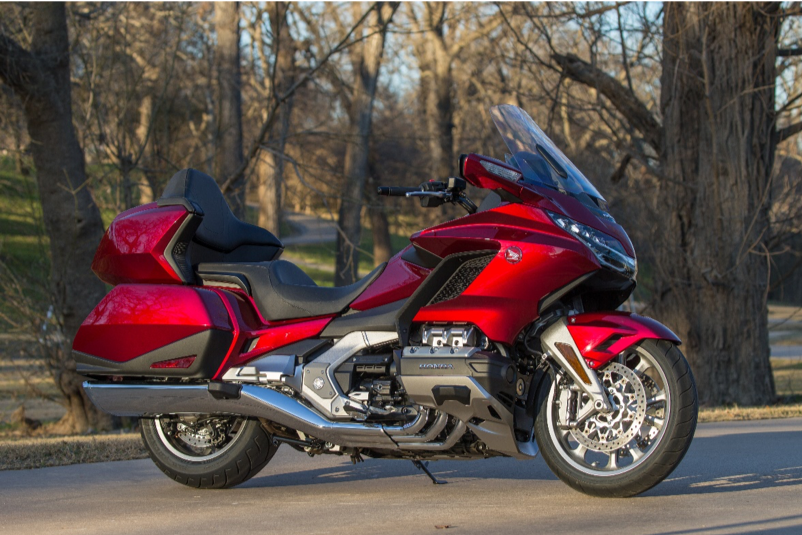
The current version of the Honda Gold Wing was first released in late 2000, so after nearly 18 years it was long overdue for a total makeover. Honda has seen a decline in sales in recent years of the bike and it was evident that this was partly because of the age of the design. Their goal in the redesign effort was challenging as they needed to not only capture the interest of new buyers, but also needed to offer something that would appeal to current Gold Wing owners. Making a bike that can appeal to both these groups is no small task, and is a bit of a balancing act. Obviously, some compromises would have to be made. Since the Gold Wing is their flagship motorcycle, they spent nearly 4 years redesigning it, filed for over 90 new patents, and produced over 100 different prototypes for the new front suspension alone before they were finished. The amount of changes made to this new model are massive, both in terms of mechanicals, and the electronics. It will not be possible to cover all of them in this article, because it would end up being a book if I tried, but I’ll do my best to hit all the high points. Having owned three of them, I have around a quarter million miles on the previous generation Gold Wing, and my wife probably has about half of that as a passenger. This review will be based on my knowledge and experience on the older generation bike and how it compares to the new one.
Honda invited my wife and I to attend the Gold Wing press launch event held in Austin Texas, and allowed us to ride the new bike through the Texas Hill Country for two full days.
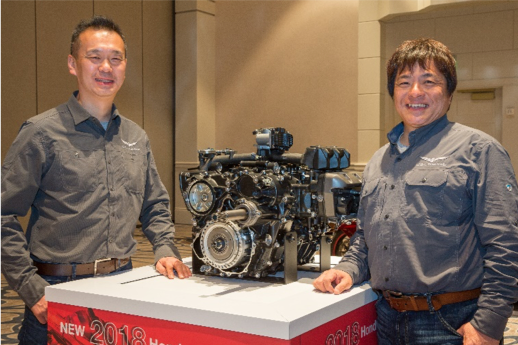
They also held a technical briefing and allowed us to speak directly with the development team leaders from Japan who are responsible for the Gold Wing design team and ask them questions. These two gentlemen, (Large Project leader - Yutaka Nakanishi (right) and Sub Large Project Leader Kazuho Nakai (left), were extremely friendly and very knowledgeable about all aspects of the bike.
Our ride started out in the cold and wet, with a constant mist/light rain that seemed to follow us most of the first day. The Texas roads we were on were super slick since it never rained hard enough to clean them off. The second day provided us clear skies, but we had stiff cross winds and 40-degree temps in the morning, which allowed us an opportunity to test the heated seats and grips. We rode the bike for over 400 miles, and were able to test out many features on it. By the end of the second day, I had become very comfortable with it.
Styling
Let’s first take a look at the styling of the new bike versus the old bike. Looking at the two bikes side by side from the front, the first thing you are struck with is how much narrower Honda made the front fairing on the new generation Wing, and they took a full 8 inches off the width. The front end also looks much less rounded and Honda has made some nice angles on the front of the bike.
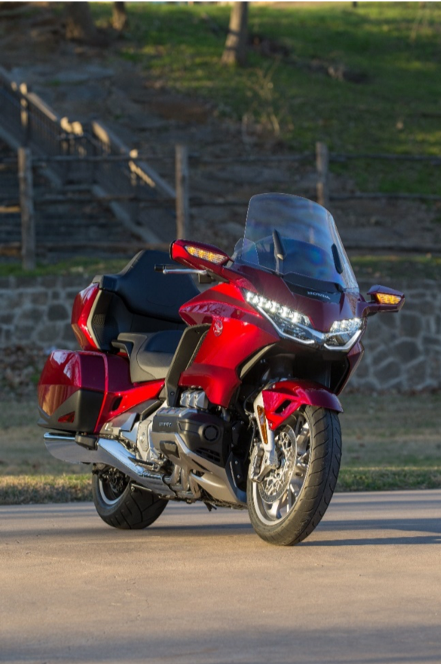
The new LED headlights really accentuate the front end. The mirrors are smaller and no longer are rounded but are more angular looking and have an open area above where they are mounted that lets air flow between the mirror and front fairing. The new electric windshield is also narrower, and fits in well with the look of the narrower front fairing. The old plastic caliper covers have been removed exposing more of the brakes, though Honda offers an optional accessory item for those who want it to more resemble the previous model. When looking at the bike head on, you’ll notice the flat 6 cylinder engine now protrudes out from the body work more than it used to. From the side of the bike the radiator opening has been reworked to match the lines and styling of the new bike and the back side of it has a black plastic deflector that forces the hot air that is ejected out away from the rider. More of the engine heads are exposed from the sides of the bike and the old large chrome tip over bars are removed and replaced with just a small plastic protrusion below the head that hides the robust tip over bar that is underneath it. The tip over protection looks more like it was designed into the bike from the start rather than bolted on after the fact, and the same holds true for the rear tip over bar that is nicely integrated into the muffler cover. Continuing down the side of the bike the rear engine covers have been removed and now more of the blacked out rear engine case and new transmission is exposed, making the bike look more like a real motorcycle and less like a large moped wrapped up in plastic. Continuing with the theme of showing more of the bikes mechanical bits, the lower exhaust covers are removed to expose the exhaust pipes and this means that the old foot flaps for letting heat onto the rider’s foot are also now gone. The old large flat sides of the rear of the fairing where the riders knee is located are now gone and are instead angled to match the rest of the bikes lines. There is a narrow glove box hidden in the right panel and the gas cap release is located inside this panel, so it no longer requires a key to operate, (but you do need to have the fob with you to open it). The seat has been entirely reworked and now no longer has the king/queen wrap-around throne look to it, but is much flatter in overall shape contributing the bikes sportier look. There is a place to add a Honda accessory rider’s backrest under a plastic cover in the seat and the passenger rear backrest is still fairly large but the armrests are slightly smaller. The old passenger cubby hole gloveboxes are gone and the rear speakers have been moved to a lower position. The lower portion of the saddlebags have a slightly textured black cover on the lower half of them that has an appealing V shape and an integrated reflector into the forward side of them. The mufflers now are more triangular in shape and the tips are more of a semi- square shape. There is a small gap on either side of the rear fender that the previous model did not have, and the rear shape of the trunk drops down at an angle so that it better matches the saddlebags. The tail lights have also been removed from the trunk which makes the available space in the trunk more usable, but takes away from the rear lighting some. Overall, the styling of the bike looks more sporty and modern and it is sure to appeal to younger riders who may have viewed the Gold Wing as an “old man’s bike”, since now it looks like it really has some sport bike DNA hiding under its bodywork. After riding the bike for a couple days and spending time around it, I was amazed how much I suddenly felt like the previous generation bike looks old, bloated, and out of date when parked next to the new one. All the other riders with us made the same comments.
Model Differences
The previous F6B model designation has been dropped and the bike without a trunk is now just branded a Gold Wing, while the model with the trunk is called the Gold Wing Tour. The Gold Wing model without the trunk is a bit more spartan and lacks some of the electronic features of the Tour model, like electrically adjustable suspension and it only gets two speakers instead of four. The top of the line model retains an air bag, and now ABS brakes are standard on all models – which is an excellent change. The Honda team informed me that they have had over 300 air bag deployments now without a single fatality in any of them, so maybe this air bag really is working. You will have to give up the center glove box though if you elect for that model, since that is where the airbag lives, and this also means your phone will have to be connected in the trunk for the Apple Car play to work.
Suspension
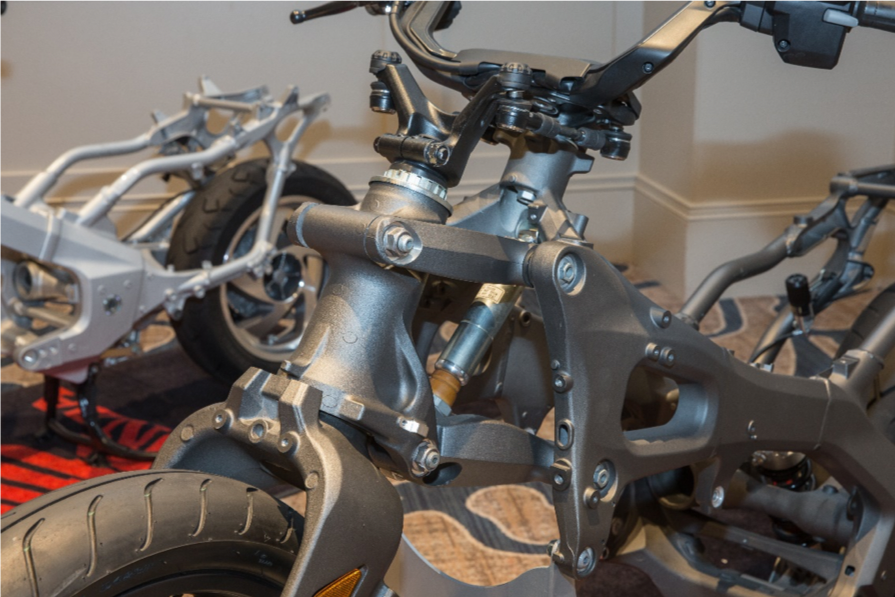
The suspension on the previous generation Gold Wing model was probably the weakest point of the bike. The anti-dive valve on it would frequently stick, and the combination of a damper rod style fork on one side and a cartridge fork on the other was simply not up to the task. The new double wishbone design front suspension Honda has put on this bike is nothing short of awesome, it is so much better it can’t even really be compared to the old bikes suspension. They have tuned the action of the front suspension to greatly reduce brake dive, but left just enough dive in to allow the bike to transfer weight forward so that the braking action doesn’t feel wooden. The design uses a single shock absorber on the front that has electronic damping adjustments on it that are controlled by what riding mode you have selected (Rain, Economy, Tour, or Sport) but the applied pre-load on the front shock spring is fixed. The pre-load on the rear shock has four settings on it now instead of using the 1-25 number system like the previous generation bike did. The available settings are for solo, solo with luggage, two-up, and two-up with luggage, and the rear shock also has automatic adjustable damping on it that is tied to the selected ride-mode. The front spring rates have been significantly increased while the rear spring rate has been slightly decreased. However, the shock linkages and dynamics have all been changed so just looking at the spring rate changes does not tell the whole story, so it’s a bit misleading to compare them on the old and new bikes. The steering system uses ball bearings like it did on the old generation bike, to provide a more responsive steering feel.

I rode the bike both two-up and solo and it handled flawlessly and really soaked up bumps. Steering response was precise and I could pick my line in a turn and hold it, or change it, with ease. I was initially worried that the tie rod design of the steering was going to reduce feedback so much that the rider would feel disconnected from the front end, but that is not the case. You can see the ends of the tie rods bouncing up and down as the suspension works, and you can still feel the road, but gone is all the jarring jolts that the rider used to get through the handlebars. The system has been carefully designed so you get just enough feedback to get some road feel, but now the suspension is actually absorbing the bumps like it was designed to, instead of transmitting them into the handlebars. The front end really feels like it just floats right over bumps compared to the old bike, and it is a joy to behold and ride. There was not even the slightest hint of the old “hands off the bars wobble” that occurred on the older bike at around 40mph. The Honda Large Project Leaders present from Japan assured me that they had engineered all that out of the bikes new front-end design and there will be no more wobble issues. The rear shock kept the rear tire planted and my passenger also noticed the rear of the bike felt less jarring when going over cattle crossings and large bumps. I really can’t say enough good things about the new suspension, it’s a night and day difference from the old bike. Honda really put a lot of work into the redesign, and it shows. When changing riding modes between Sport to Tour settings, I could detect a change in the suspension damping, but it was somewhat subtle. The change to the rear preload provided a more noticeable change. Ground clearance also seems to be just slightly improved. My 2012 Wing had nearly $3,000 worth of Traxxion Dynamics suspension upgrades on it, and this new bike still handles better in stock form, and that is saying something because I had that bike about as dialed in as a Gold Wing could be. The only room for improvement I can see would be to allow the electronic damping adjustments for the shocks to be set independently from the selected ride-by-wire throttle mode.
Engine
The engine on the new Gold Wing retains the flat six cylinder layout, but many things have changed on it. Honda reduced the spacing between the cylinders and relocated some components on it to shorten the engine by 29 millimeter. This allowed them to move the engine further forward and move the rider closer to the windshield. The cylinder heads now use 4 valves instead of two and uses Honda’s new uni-cam system which employs roller rockers on the exhaust valves with directly actuated intake valves. It’s also worth mentioning the fans no longer blow forward, and instead eject air out the sides of the bike.
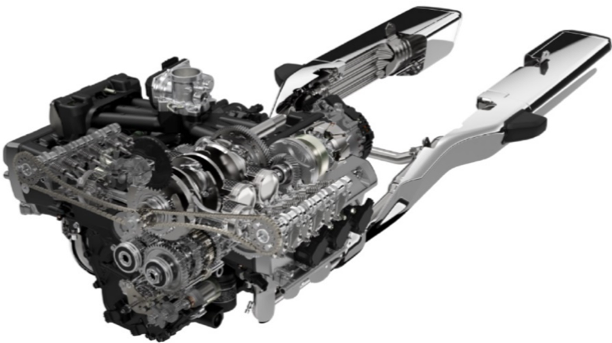
They have also added individual spark plug coils for each cylinder directly over the plugs, eliminated the plug wires that were on the old wasted-spark ignition system on the old bike. Horsepower and torque are slightly improved, as is volumetric efficiency of the engine, which should provide better gas mileage. The engine still retains a similar feel to the old bike, and has plenty of power and torque on tap. The weight reduction and reduced wind drag from the narrower fairing also helps here, making the engine feel more responsive.
Weight Reduction/Frame/Luggage Capacity/Gas Tank Volume Reduction
Make no doubt about it, this is still a fairly heavy bike, but the 90-pound weight reduction makes a noticeable improvement. Honda dropped the weight in several interesting ways, like adding a CAN bus which dropped 10 full pounds off the wiring harness, and combining the starter and alternator into one unit.
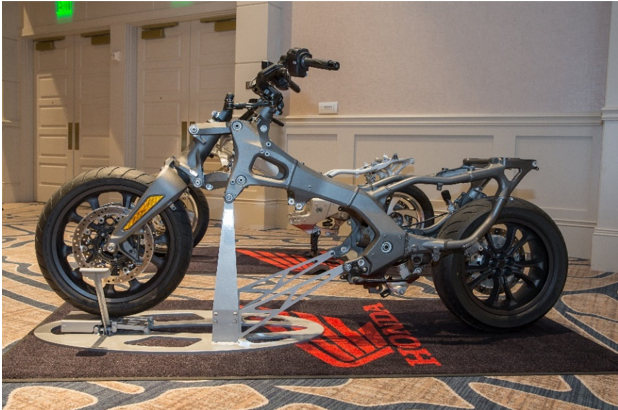
The frame was also redesigned to not only make it stiffer, but also lighter, and they reduced the number of welds in it as well. The first few model years of the previous generation Gold Wing suffered from frame cracks in the lower cross member welds, and on the new bike that same cross member is now one solid cast piece, so there are no welds on it to fail anymore. Honda also reduced the number of pieces in the frame from nearly 20 on the old bike to only 4 on the new bike which greatly reduced the number of welds needed. The entire frame is now not only more robust, it is more ridged, and weighs less. And all the welds on it are now done robotically instead of by hand.
The gas tank volume has also been reduced by roughly one gallon. This also contributes to the weight reduction, but according to Honda, the loss in range is compensated for by the new uni-cam four valve per cylinder engine which provides better gas mileage. On my ride, I got an average of 39.5 mpg when checking gallons put in against the odometer. The new mpg readout on the dash reported 40mpg, so it seems like it is fairly accurate. You can probably expect to need to start looking for gas at right around 200 miles. I was not able to determine if there was any speedometer or odometer error though, but Honda fixed the speedo error in 2009 on the older bikes, so I would assume it reads correctly on this one too.
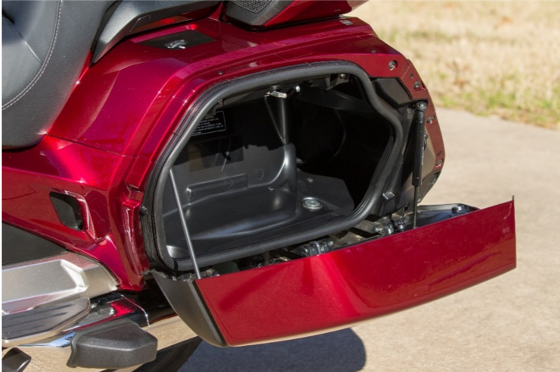
The luggage now all opens via small electric push buttons instead of the old style mechanical release mechanism that was problematic on some bikes in the past, and the doors and trunk lid have dampers on them. The luggage space is reduced in both the saddlebags and trunk by about 40 liters total, and the small passenger glove boxes at the rear of the bike are gone, which my passenger missed because she kept warm and cold sets of gloves in them so she could switch in-flight. My wife and I were able to pack the bike with everything that we normally need on a 2-week trip and it all fit in the bike. It was however a tighter fit, and we did have to leave some items at home, like my tool kit, half cover and the wife’s extra pair of shoes, but overall that seems like a small compromise to make for so many other good improvements this bike has. I think this bike is just going to force riders to relearn how to pack and really evaluate what things are important for them to bring and what they can live without. We both packed three changes of clothes, and our heated liners and rain suits and bathroom items in the bike along with a laptop and spare gloves and it all fit with even some room leftover in the trunk. Our method of travel is just to stay in hotels with laundry machines and wash our clothes every third or fourth day - or whenever the smell gets so bad that even pets won’t come near me. That’s usually how I know it’s time to wash.
Ergonomics
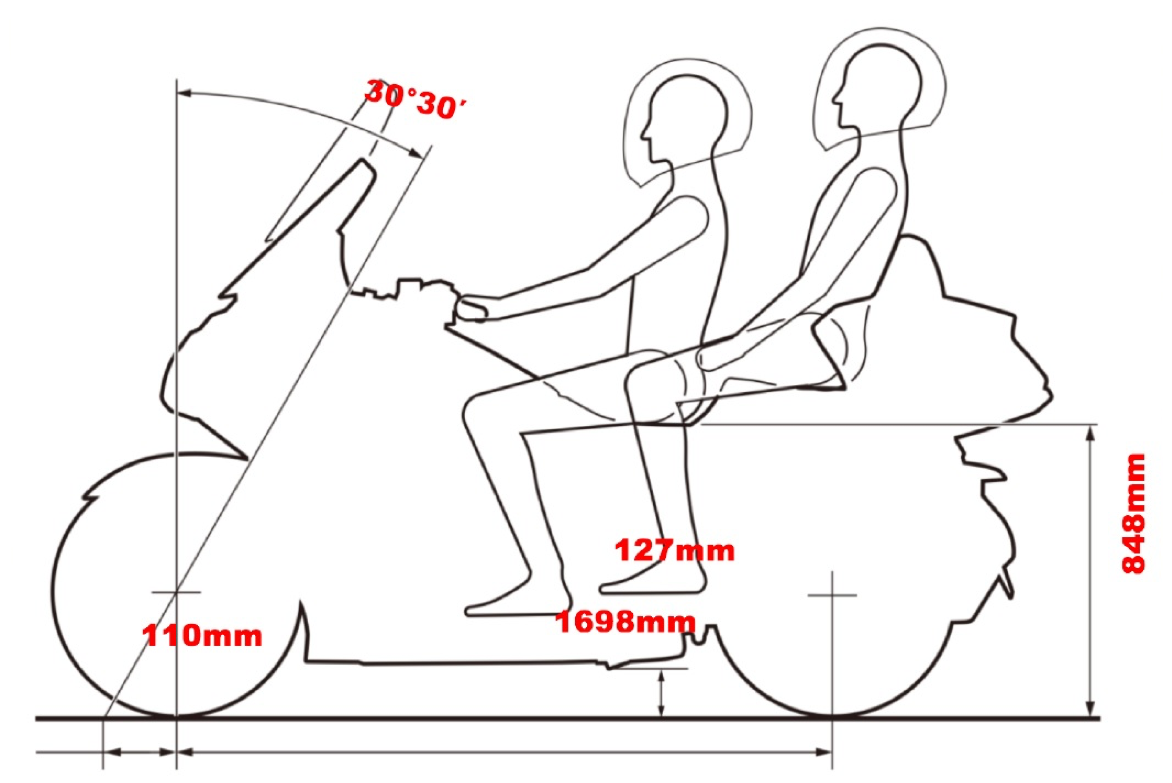
The reach to the bars and foot pegs felt perfect and very natural for me. I had no issues with the seating position at all. The new seat is flatter than before and felt good on an all-day ride. Moving the engine further forward has also provided more space for taller riders whose knees would previously be up against the fairing on the old bike. My passenger reported that she felt like she sat a little more upright on this bike as compared to the previous model, and she also commented that while she felt fine on the new bike, the seat was not as soft and comfortable as the old bike and she did not feel as secure in her perch as before.
The passenger grab rails are placed too low and too tight into the bike. All the passengers on our ride complained about them and we spoke with the Honda Project Leaders present about it and I believe they have some ideas on how to improve it and may possibly offer an accessory item in the future. We also rode a bike that had the accessory arm rests mounted on it, and this did help, as it at least provided the passenger something to clutch onto when the riding became spirited.
Wind Protection/New Electric Windshield/Mirrors
The new electric windshield is something Wing owners have been wanting for a long time and being able to adjust the windshield in both height and rake angle on the fly is a big improvement. The new windshield is narrower on this bike than it was on the previous generation, to match the narrower front fairing. I did notice a reduction in the amount of buffeting I got on the top of my helmet, it was pretty much non-existent, and while there is more airflow in the cockpit, it is smoother. I would however like to see the windshield widened about 3 inches so it would provide better coverage on the sides. I could feel more wind on the sides of my helmet and on my arms and sides of my legs and feet, and this did result in a slightly colder feeling on my extremities when riding in cold temps without heated gear compared to the previous generation bike. Once we got our heated gear hooked up and turned on, we had no complaints and I’m sure that in the summer time, this increased airflow is going to be a good thing. My passenger reported that the amount of wind on her was about the same, or maybe a little bit less than on the old bike. The electric windshield automatically retracts when you shut off the bike and it has a memory so it returns to where you left it once you start moving beyond about 5mph. You can also prevent the windshield from retracting when you power off the bike by tapping the windshield button as the bike powers down.
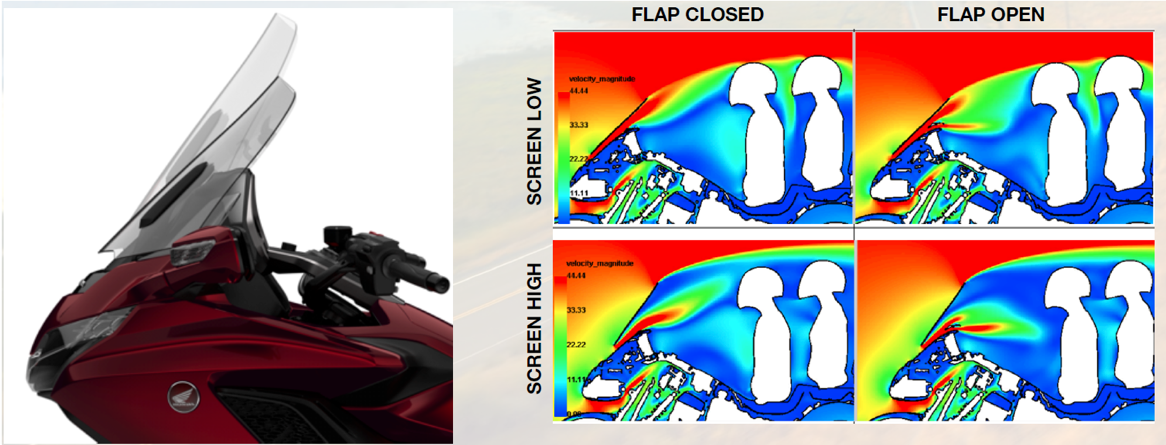
When first looking at the mirrors I noticed right away how much smaller they looked than the previous model. However, once riding, I quickly discovered that the mirrors worked very well, and I had no issues being able to see everything I needed to behind me. They also were very stable and I didn’t see any vibration in them at all. So, while the mirrors appear to be smaller, don’t let them fool you, they work just as good as the ones on the previous bike.
Ride Modes/Ride By Wire Throttle Control/Cruise Control
Hondas ride-by-wire throttle control provides some interesting benefits, as it allowed them to incorporate four different ride modes which alter the response of the engine to throttle input. Put it in Rain or Economy mode and the bike suddenly feels like it lost 2 cylinders. Put it in Sport mode, and you better start practicing smooth throttle control because it reacts a lot faster with a lot less throttle. The Tour mode results in what I would call the most natural of the four modes and is the easiest to ride with and this is the default mode the bike starts up in when you turn it on. I could not detect any lag associated with the ride-by-wire throttle system, and if you hadn’t told me, I wouldn’t even have known the bike didn’t have a throttle cable anymore, it felt completely natural. The new HSTC Torque control system (or traction control) also uses the throttle by wire system to reduce throttle input automatically when it senses rear wheel slip, and this function can be turned off through the menu if desired. Two riders in our group told me that they inadvertently engaged it when we were riding in the rain, and it worked as advertised, and basically ignored their throttle inputs until the bike regained traction. The cruise control on the bike worked very smoothly and had none of the lag or delay that the previous model did when engaging it. The addition of the cruise control set speed being displayed in the left LCD allows you to know exactly where it is set at, and you can add or subtract from it in 1mph increments using the set and resume up and down buttons on the right handgrip. You can also cancel the cruise control without hitting the brakes by simply clicking the up-shift trigger button on the DCT bike.
Infotainment
Who would have ever thought a motorcycle would have an “infotainment” system on it? Probably the same guys who thought a bike would never have an automatic transmission. Well, this bike has both. I was able to use the Apple car play function and listen to my music, make phone calls, and even compose text messages through my finicky Sena Bluetooth headset, (which actually worked some of the time).
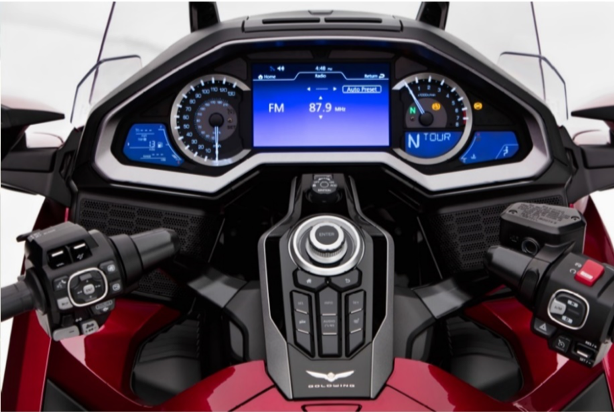
I could even engage Siri (when my Sena 30K headset wasn’t acting up) and have her bring up the Iphone maps and route me to a destination, while the Iphone maps displayed on the screen. The only catch is that in order to use the Apple Car play function, you first need a (working) blue tooth headset that is paired to the bike, and then you plug the Iphone into the connector in the glove box. You have to turn off the Bluetooth on your phone to use Apple car play and all the phone data is passed through the wired connection of the phone to the bike. Since the bike no longer has a connector for corded headsets, you’ll need to have a (working) Bluetooth headset if you want to use Apple car play or get any audio from the system.
Did I mention I had problems with my Sena 30K headsets working right? Others on the ride who used the older Sena 20s model did not have the problems I did, so maybe Sena just needs time to work some more of the bugs out of this new model. Two other couples were also using the Sena 30k they both reported issues with them as well, so at least I know it wasn’t just mine. When they worked they sounded great, but they only worked for about a quarter of the time, and one of them totally died and wouldn’t even turn on anymore - even with a full charge on the battery. I also heard one of the Honda team members saying he was having problems with his Scala rider headsets, so I don’t think Sena is the only one having issues. It was rather comical to watch one of the riders in front of me slapping the side of his helmet as we were going down the road, in an attempt to get his headset working again. I feel like the Bluetooth headset technology may just need some more time to mature, and hopefully they will get better as time goes on. The Goldwing is the first bike I know of that has incorporated this from the factory, so maybe this will spur the manufactures to fix some of these problems and come out with improved models.
It can take some practice to get the various volume controls in the system all properly balanced since you have a volume for the phone, siri volume, navigation volume, headset audio system volume, phone microphone volume, external speaker volume, and a separate volume on each Bluetooth communicator on your headset. The source button on the left handgrip allows the rider to cycle through the available audio sources of FM radio, AM radio, Sirius radio, and Aux, and if you bring up Apple car play you have access to all the music and playlists on your phone as well, so you shouldn’t have any problems finding something to listen to on those long rides. Additionally, the optional audio control for the passenger provides a way for your passenger to control the bikes overall audio system volume level, source, and track. If you have two phones, you and your passenger can even listen to different things at the same time by pairing your passenger’s headset directly to their own phone and bypassing the Honda system. The stock amplifier is only 20 watts per channel and if you use the external speakers, you need to run it nearly full blast at speeds over 60mph to hear it. The Honda accessory 200-watt amplifier and upgraded speaker kit will solve that problem, but you will lose space in the left saddlebag where the amp is mounted.
Navigation Unit
The Navigation unit has been totally changed for 2018, and Honda now uses a Harman Navigation unit instead of a Garmin designed one. The display seemed bright and easy to read but the small road level details still disappear if you zoom out past the 1.2-mile range setting, which is a big annoyance and makes it hard to see where you really are when you zoom out. It does display Town/City names, but the fonts and colors it uses for them are a bit hard to read, I’d like to see them changed to provide a higher level of contrast against the background. Unfortunately, we were not able to load a route into the bike due to problems with the Honda Trip Planner website being down at the time of our ride. I was informed that routes can only contain 8 waypoints in them, and this seems to be a huge limitation of the system.
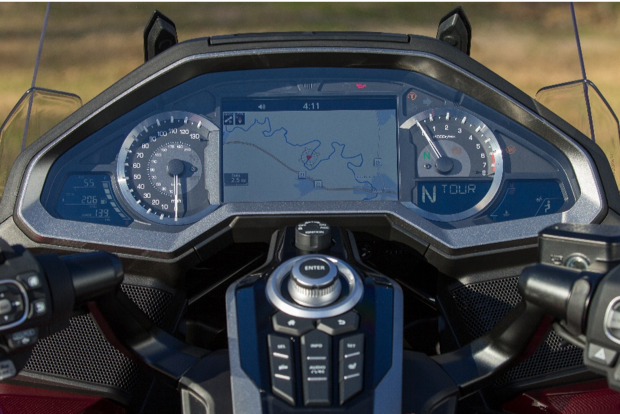
Even the Honda team members present were not able to create a route for our 200-mile ride from Austin to Fredericksburg with this limitation, and they said the only way they could do it would be to break it up into two routes. I attempted to load a route I had created from the Garmin Basecamp program saved in a GPX format file, and I was able to import the route into the bike, but I could not get it to activate for some reason. Motorcycle Navigation unit manufactures need to understand that riders want to be able to create very specific routes to a destination that take them on the roads they want to ride on, and the only way to do this is to create routes with many waypoints in them to force the Nav unit to follow the route they want to take. An eight-waypoint routing limitation is quite frankly unacceptable on a motorcycle GPS. This is something that hopefully Honda and Harman will address soon and correct. The Nav unit zoom levels can be controlled via the up and down buttons on the left handlebar multi-way switch. The XM Weather subscription was not activated on our bikes, so I was not able to see how the Doppler radar screens looked. One bright point of the system is there is no longer a need to acknowledge the old GPS Legal nag screen like on the previous bike. This is a great move in the right direction, and I applaud Honda and Harman for doing this, as it would lock you out of the GPS system on the previous model if you forgot to acknowledge it.
Apple Car Play
The new Apple Car play feature on the 2018 Gold Wing is the first of its kind, and I can tell you it is a joy to use. It provides you instant access to Siri though a dedicated button on the left handlebar enabling you to ask all kinds of questions like how far is it to my destination etc. This also allowed me to ask Siri to take me to a location and it would build a route on the fly and then bring up the Apple maps on the screen which show me the distance and time to destination, distance to next turn, and even the speed limit on the current road. The maps from the Iphone just seem so much better than any of the other navigation systems I’ve used. The only catch is you need a cell tower connection, so if you’re out in an area without a connection, your maps won’t work, and neither will Siri. You also can’t create a multi-point route on the Iphone, so you’re limited to just having it route you to a single destination. With Apple Car play, I also have full access to all my music and playlists and contacts on the phone. Not all apps are available through the Apple car play function though, and I was not able to find a way to bring up the weather radar from my phone on the screen, which I would have liked to be able to do when we rode in the rain the first day.

Moving around some of the menus using the 4-way switch on the left handlebar can take some time to learn, as moving the cursor is not always intuitive. Sometimes you have to move the switch up to move left or down to move right and it can be a little bit of a challenge as a result to navigate through the screens when riding. Android user can’t play unfortunately, but Honda may later release an update that allows Android phones to work on the bike.
Menu Control/Jog Dial Function
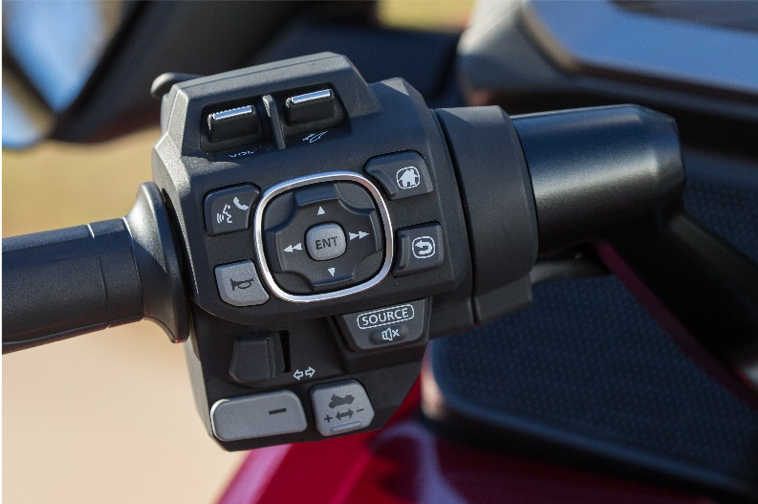
Honda worked hard to try to declutter the cockpit I believe they did a good job. Instead of having dedicated buttons for everything, they moved some of the less used functions to a menu system which is driven by the jog dial in the center of the console. This dial is disabled while moving, but you really don’t need access to most of the functions that are in the menu when you are moving anyway. Things like Bluetooth set up and rear spring preload and others are in the menus. Items like the heated seats and grips have their own dedicated buttons in the center of the console so they can be adjusted on the fly. Honda did a good job of finding a happy balance between using dedicated buttons, and menu driven items. It is also worth noting that they no longer use the old square style push and lock buttons that so frequently froze or failed on the old bike. All the buttons are now simple press and release. The left handgrip has a new 4-way multi switch that can be used to control many functions on the Nav and Apple Car
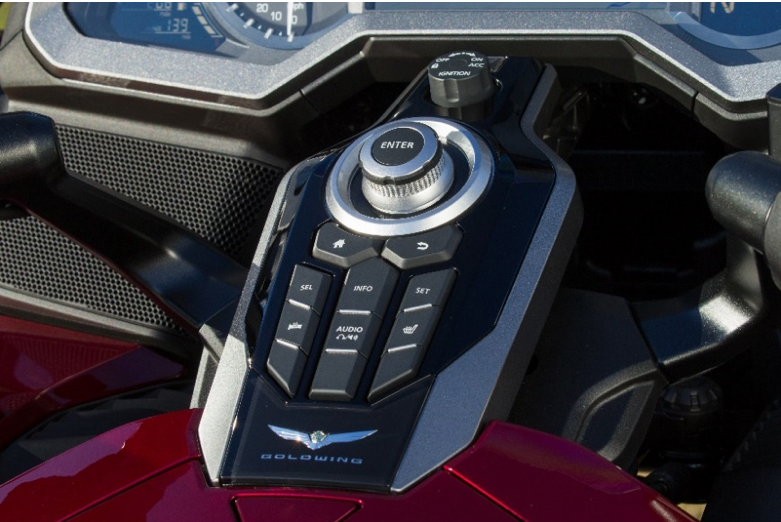
Play systems, though it sometimes isn’t obvious which direction you need to press it to change functions. There also is a Home, Back, voice (Siri), and source button on the left grip. The starter button has now been integrated into the kill switch, you rock it forward to engage the new integrated starter/generator (ISG), which is now mated to the engine through a rubber cush drive, instead of the old spring style alternator drive gear (ADG), which used to cause problems on the previous generation bikes. This new rubber cush drive on the starter greatly reduces the noise of the starter motor as well when it engages the engine and starts the bike.
Display
The new display is well designed and easy to read in direct sunlight. Various information is displayed in the right and left corners of the screen in smaller LCD displays for things like the trip meters, ambient air temperature, range to empty, cruise control set speed, and tire pressure data. And yes, you can now see the actual tire pressures however you can’t see both tire pressures at once so do have to press a button to cycle the display between the front and rear tires. The heated seat and grip settings are displayed using small bar like indicators in the right side of the display, and you also now get an indication when the passenger heated seat is turned on. On the old generation bike, it was easy for the passenger heated seat to be left on and you wouldn’t know it unless you checked the switch, so this is a welcome change.
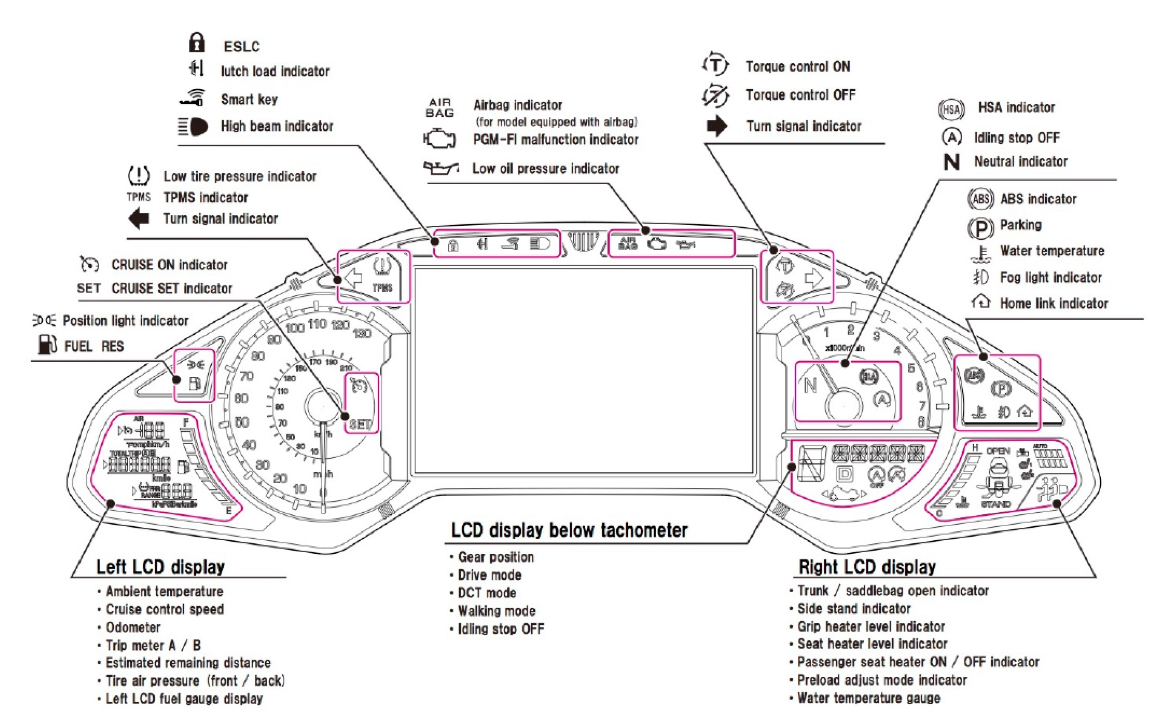
The only criticism I might have is that some of the indicators and readouts are a bit smallish. Honda retained the analog style speedo and tach but swapped their left and right positions. A gear indicator was added as well as what riding mode you have selected and the DCT model bike shows a small D when the bike is in the Drive mode, which goes away when you put the transmission in manual shift mode. The lower portion of the display also displays your average MPG for trip meter A and B and can show instantaneous MPG was well by cycling though the Info button on the center panel.
Heated Seats and Grips
The heated seats and grips seem to work better on this bike than they did the old one. They get warmer and I was not able to ride with them on full blast, even in 40-degree temps. My wife also noticed the passenger seat seemed to get warmer. Hopefully they won’t be as problematic as they were on the older bike. The passenger heated seat control is now on top of the left saddlebag, and it seems to be designed better and appears it won’t have problems getting stuck like they sometimes did on the older model. As I mentioned above, there is also an indicator on the dash to let you know when the rear heated seat it turned on, which is a nice touch.
Lights/Indicators/Horn/Ignition
The new LED headlights work well, and illuminate the road nicely. They also provide a more modern styling cue to the overall look of the new front end. The headlight height adjusters are now manual, and you cannot reach them while riding. The electric adjusters on the previous generation GL1800 worked very well and on models prior to 2012 you could even trim out the headlights on the fly, which was a very useful feature. It’s too bad Honda didn’t keep this feature on the new bike. The headlight hi/low button is on the front of the left grip and incorporates a handy flash-to-pass feature in it. The front turn signals are integrated into the mirrors and are very bright when in use. The rear turn indicators are built into the single tail light assembly and the turn signal auto cancel function remains, but it no longer uses a steering angle sensor like the old bike did. It isn’t real clear to me how the cancel function is implemented, but Honda told me it looks at the front and rear wheel sensors to count rotations. It does seem to work well, however the turn signals still cancel way too soon (12 seconds), and several times I had to put them on two or three times before a turn because of this.
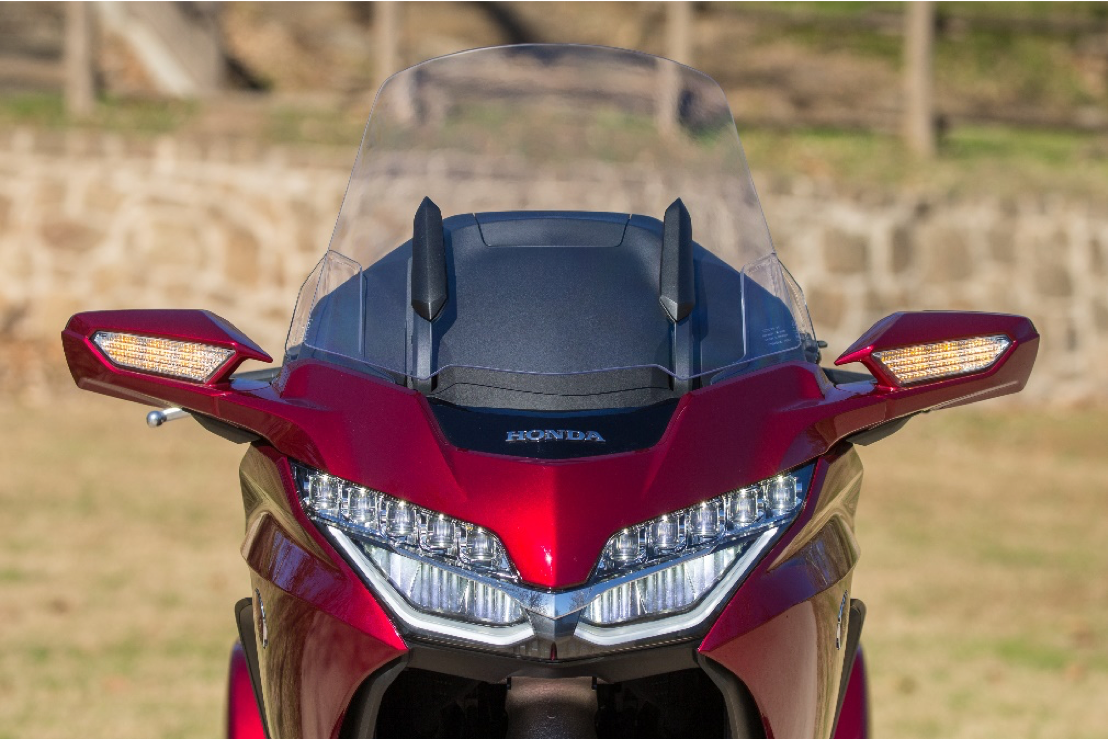
The horn retains the dual horn set up of the old bike, and is just as loud, though the tone seems just a little more shrill. The horn button is easy to find and use. Nearly all the buttons are back lit on the handlebars, and this helps locate things in the dark. The bike uses a new key fob instead of a traditional ignition lock, and you turn the bike on and off with a single round rotation type knob in front of the jog dial controller. The fob also has an off button on it so that you can prevent it from transmitting and allowing the bike to be started in the event you are sitting nearby and still want to secure the bike. This feature would also allow you to hide a spare fob on the bike somewhere. The saddlebags, glovebox, and trunk also automatically lock and unlock when the fob is present which is a really nice feature. Oddly though the center glove box where you store your cell phone is not lockable. Honda only provides one fob on the US model bikes (Canadians get two) which is unfortunate as loss if it may result in an expensive trip to the dealership. A second fob costs around $90 and would probably be a good idea to purchase as back up. Honda provides you with a code on a small piece of paper attached to the fob when you purchase a new Wing, and this code can be used through a special process of button presses to start the bike in the event you lose or damage your key fob.
DCT Versus Manual Trans
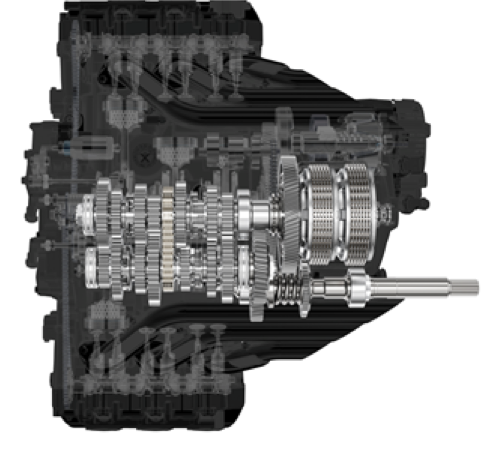
When I first heard Honda was going to put a Dual Clutch transmission on the new Wing I thought to myself that I would never want one. I mean what self-respecting rider wants an “automatic transmission” on a bike? Sounded to me like a good way to get your man card revoked. Much less how much fun it would take out of riding. Boy was I wrong. This DCT transmission could not be a better match for this bike. The butter smooth operation and the multiple modes make it easy to find a mode that suits you. The up and down shift trigger-buttons on the left grip are easy to locate and can still override the system even when it is in full-auto mode, though the bike will drop back to auto a few seconds afterwards, so if you want it to hold a gear you need to put it in manual mode. The various ride modes also change the shift points of the transmission and when in “sport” mode it will downshift more eagerly with throttle input and will upshift at higher RPMS. Rain and Economy modes make it have a lazier shifting style. The tour mode is the one that is probably going to be used the most as it results in the most natural shift feel. It’s a bit hard to describe how smooth and fast this transmission shifts. You have to ride it to understand. I purposely started up and down shifting in the middle of corners to see just how well it did, and I was able to do three shifts in one corner with the bike at full-tilt without it upsetting the suspension or my line in the turn. Try doing that with a manual transmission bike. It took me most of the first day to get used to the DCT, but by day two, I was in love with it.
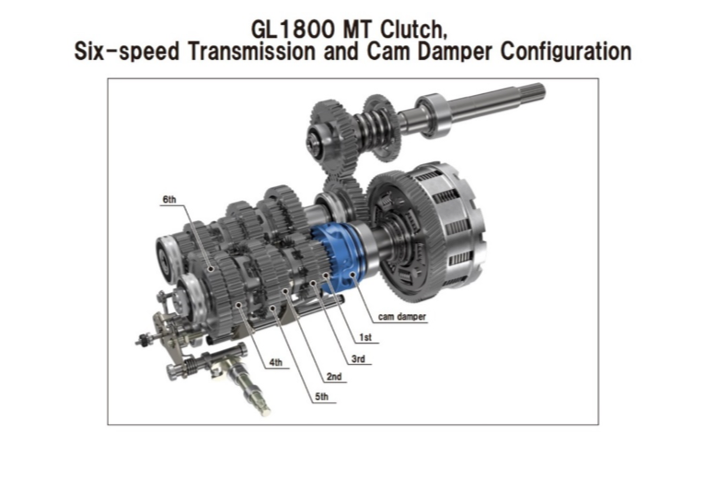
I also rode the manual transmission bike and it shifted well, and I liked the addition of the 6th gear. The clutch engagement point seemed to be a bit further out though, and this took some getting used to. It also could have been that the clutch lever adjustment point was not set right for me, and I didn’t have time to check it. The new manual transmission incorporates a new cam damper to reduce shift shock and the transmission did seem to shift smother and quieter than the previous model bike. The manual transmission bike also has a slipper clutch and the 6th gear ratio on the manual transmission bike is the same ratio as 7th on the DCT model. One thing I didn’t expect when I rode the manual after riding the DCT model was that I suddenly became conscious of just how much I was upsetting the suspension every time I shifted, with the bike rocking fore and aft every time I used the clutch. After riding the manual transmission bike for a few miles, I was ready to switch back to the DCT bike. Not that anything was wrong with the manual bike, but the DCT was just so much better and smoother. It simply can out shift me even on my best day. I’m sure there will be lots of holdouts that don’t want to get the DCT transmission, and that’s ok. But I would encourage folks to at least take a test ride on one before making up their minds. If you had told me a few years ago that I would one day own a motorcycle with an automatic transmission I would have laughed at you. Not anymore.
Walking Speed Modes, Parking Brake, Hill Start Assist
The reverse mode on the manual transmission bike works like it did on the older bikes, by using the starter motor to reverse the bike. On the DCT model, you put the bike into the “walking mode” by squeezing the front brake and pushing the walking mode button on the left handlebar. You then use the manual shift up and down trigger-buttons to go forward or backward. I used it numerous times during the course of my ride and it worked very smoothly and I was even able to use it in deep loose gravel in a parking lot to help maneuver the bike into a parking spot. I was really impressed with how it worked overall. The standard GoldWing model (the one without a trunk) does not have a reverse on it.
The DCT bike has a parking brake on the left side of it, which seems a little odd on a motorcycle, but it is needed because when the bike is shut off, it is always in neutral, so there is no way to leave it in gear. There also is an indicator on the dash to tell you when it is engaged. To release it, you simply pull up on it a bit and it releases. The cable that goes to the new parking brake caliper on the rear wheel is the only cable on the entire motorcycle. There is no interlock mechanism on it though, so you can put the bike in gear and ride off with the parking brake engaged. This probably needs to be corrected.
The Hill assist mode on the bike is engaged by squeezing hard on the front brake lever while stopped. An indicator on the dash comes on to tell you it is engaged, and it uses the brakes to hold the bike while on an incline. As soon as you apply throttle and the bike starts to move even just a little it automatically unlocks. This is a useful feature on the DCT bike since you don’t have a clutch to help you hold the bike on a hill, and it saves wear and tear on the DCT dual clutches.
Brakes
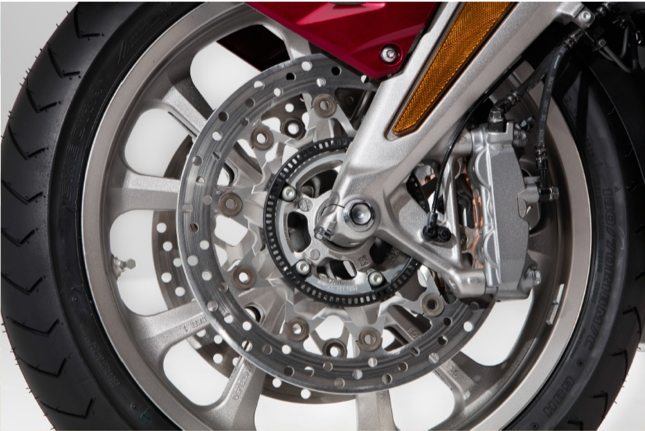
I had several opportunities to do some pretty hard braking on the bike, and I was impressed with the improvement in them over the previous bike. The weight reduction also helps here. I wasn’t able to do any definitive testing, but I could immediately feel an improvement in braking force from the new larger diameter rotors. The addition of ABS as a standard on all model Gold Wings is also a welcome improvement. As you change the ride modes, it also changes the way the brake bias is set on the combined brake system. Honda told me that in sport mode, more bias is given to the rear wheel to help the bike squat more when going into a corner to set the suspension. As on the old bike, to get all six pistons applied on the front brake, you also need to use the rear brake pedal as this is how the combined braking system works. So, to get maximum braking you will need to use both front and rear brakes together.
Speed Limiter
Unfortunately, Honda put an upper limit on the fun by adding an electronic speed limiter, which is set at 112mph, or 180km. The limiting is done internally in the engine control module (ECM). I expressed to the Honda design leads who were present at the event that I thought this should at least be 120mph and that 112 seemed a little low to me. My advice would be not to try to outrun the police on this bike or use it to haul moonshine.
Overall Riding Impressions
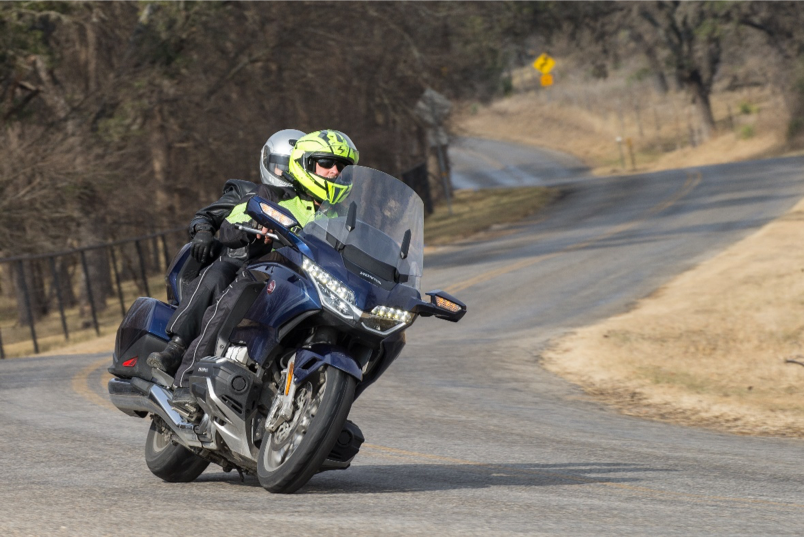
This bike is simply a joy to ride. The weight reduction is immediately noticeable and makes the bike feel sportier. It also looks more streamlined and modern. It feels like a cross between a sport touring bike and a full up Luxo-Touring bike. I think it’s going to capture some new riders that thought they would never own a Gold Wing, and I also think it’s going to be more appealing in some overseas markets that may have previously thought the Goldwing was too big. Everyone on the Gold Wing forums complained loudly and often about the reduction in luggage when the bike was first announced, but my wife and I had no issues packing the bike for a two-week trip and we were able to get everything we would need in it, (but maybe not everything we wanted). The improvements that the new double wishbone front suspension provide transform this bike, and make it less tiring to ride long distances. The Apple car play and electronics package provides riders a level of assistance on the road never before available on any motorcycle, this is a game changer. The new DCT transmission is an absolute joy to use and the addition of the various modes of both the transmission and ride modes make this feel like two or three different bikes in one. And if you like a manual transmission you now have the six speed everyone has long been asking for and it also shifts smoother. I’m simply in love with this new Wing, Honda knocked this one out of the park. I think my wife summed it up best when she told me that the new bike makes her feel younger when she is sitting on it. I believe that was the green light for me to trade my old one in.
Complaints (OK no bike is absolutely perfect)
Nav unit routing problems - 8 waypoint limitation, seriously?
Windshield needs to be about 3 inches wider at the top
Passenger grab rails - expect an optional accessory
Loss of electric headlight adjustment
No parking brake interlock
Suspension damping adjustments tied to ride-mode
Apple car play menu navigation not intuitive (left = down?)
Speed/fun Limiter – set too low
Turn signals still cancel too soon (12 sec), Honda should have fixed this by now
No wired headset connection option or built in intercom function
Loss of rear passenger gloveboxes
Android users left out in the cold
Bike should come with two key FOBs
Center glove box should lock
- No Comments Yet -